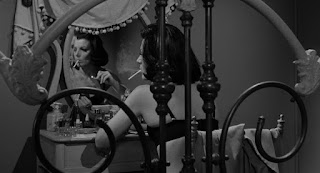Experiment in Terror is a 1962 psychological thriller produced and directed by Blake Edwards.
I have mixed feelings about Blake Edwards. I regard him as very much a hit-or-miss film-maker but he made some interesting movies. If you’ve seen his 1958-1961 TV series Peter Gunn you know that Edwards had some fondness for the look and feel of classic film noir. Experiment in Terror is not film noir and it’s not neo-noir but it does display plenty of film noir stylistic influences. There are lots of Venetian blind shots!
The opening is extraordinarily harrowing and it’s a fine example of terror being much more effective without the use of blood or overt violence. Edwards relies on a sense of overwhelming menace and madness. A pretty young woman, Kelly Sherwood (Lee Remick) is attacked in the garage of her house by a man whose face she cannot see. She thinks she is going to be raped. The viewer will make the same assumption. That’s not what happens. Not quite. What happens is a violation, but it’s a violation of her whole life, her sense of herself, her sense of living in a sane ordered society. Her attacker is not motivated by lust for sex but by lust for money. He intends to force her to help him to rob a bank.
It’s not a rape, but there is a sense of sexual menace. There is an implied threat that if she doesn’t play along she might be raped or murdered, or both. And there is an overt threat that her kid sister Toby will suffer a similar fate.
Kelly decides to call the F.B.I. and now she discovers that her attacker is watching her constantly and knows every move she makes. She’s now in even more danger but the F.B.I. is now involved, in the person of Special Agent John Ripley (Glenn Ford).
The planned heist plays little part in the movie. The focus is on Kelly being the prey for the psycho (we later find out his name is Red Lynch), while Red Lynch is the prey being hunted by Special Agent Ripley. Two cat-and-mouse games are going to be played out and they’re played out in an effectively suspenseful way.
One thing that’s interesting is the relentless minimalism of the characterisation. We get no backstory whatsoever on Ripley. We get absolutely no backstory on Kelly Sherwood. More surprisingly, we are never given any backstory on Red Lynch. Everything we know about these three key characters we know from their reactions to the events of the movie. It’s obvious that Ripley is very professional but his concern for Kelly’s safety is genuine.
We can see that Kelly is tougher than she appears on the surface - she doesn’t fall apart in situations in which she could be forgiven for doing so. We know she’s raised her kid sister and she seems to have done a good job. The bank trusts her to handle large amounts of cash. She’s obviously sensible and responsible. We see a guy at the bank ask her out and clearly the two of them date regularly. She has a normal emotional and social life. It’s the very normality of her that makes Red Lynch’s violation of her life so shocking.
As for Red Lynch, we get lots of tantalising hints. We know he’s a ruthless killer but he’s paid all the hospital bills for Lisa Soong’s sick son. We don’t know why. Does he have a sentimental side, or is this action driven by guilt of some sort? He may have a relationship with Lisa Soong, and possibly with mannequin artist Nancy Ashton. But are these normal sexual relationships? The fact that he has the opportunity to rape both Kelly and Toby and that he enjoys making them think they’re going to be raped but he doesn’t actually do it leads us to suspect some severe sexual dysfunction, and we suspect that that is his major motivation, but all we have are hints. We’d like to know more.
It’s possible that Blake Edwards was worried that over-explaining the character would lessen the movie’s impact (which had been a slight problem in Hitchcock’s Psycho two years earlier). I do suspect that this characterisation minimalism must have been a deliberate choice. The movie has a relentless focus on the dynamic between Kelly and Red Lynch and there’s nothing to distract us from it. That’s presumably why there is no hint of any romantic attraction between Kelly and Ripley. That would have resulted in a totally different movie.
I think it’s reasonable to see some Hitchcock influences on this movie (and in 1962 it was pretty difficult to make a thriller without being influenced to some degree by Hitchcock. The themes of surveillance and voyeurism suggest a Hitchcock influence, the San Francisco setting calls to mind Vertigo and I think there are touches of both Psycho and Dial M for Murder.
This is a beautifully shot movie (Philip Lathrop did the black-and-white cinematography). The visual style is not quite film noir, but with strong noir affinities.
I don’t think there’s any other movie quite like this one in Blake Edwards’ filmography. It’s a very effective slightly noir-inflected slightly Hitchcockian thriller and I thoroughly enjoyed it. Highly recommended.
The Powerhouse Indicator Blu-Ray looks lovely and includes a number of extras.





Hmm, a Glenn Ford movie I really haven't heard much about -- thanks for the great write-up! I may have to dig up a copy of this.
ReplyDeleteIf you're a Glenn Ford fan it's definitely worth seeking out. Another obscure Glenn Ford movie from around that time that is very much worth seeing is The Money Trap (1965). I reviewed it back in 2013.
Deletehttps://dfordoom-movieramblings.blogspot.com/2013/02/the-money-trap-1965.html
Thanks for the rec!
Delete